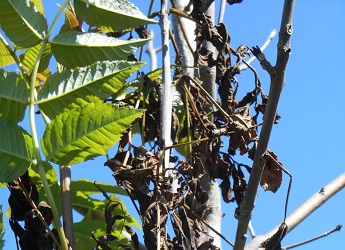County Councillor for Gartee
Ash Dieback in Leicestershire
Ash dieback will desolate many of our rural roadsides and landscapes. This is a serious disease of ash tree. It is caused by the fungus Hymenoscyphus fraxineus (it used to be called Chalara fraxinea). The fungus is spread by the wind or by the movement of diseased ash trees. The disease causes leaf loss and crown dieback in affected trees and can lead to the death of the tree. The disease was first identified in England in 2012. Research has shown that it is likely to have been present since at least 2005.
Ash dieback in the Kibworths
The disease is causing widespread decline of ash trees in Leicestershire and this is expected to continue. There are no exact figures for the number of ash trees in Leicestershire, but it is estimated that there are over 500,000 in the county. Many of the individual trees alongside the A6 between the Kibworths and Market Harborough are ash. Sadly most are showing severe signs of the disease.

It is likely that the majority of our native ash trees will exhibit symptoms of ash dieback, but not all that do will die. A small percentage of ash trees will have a degree of tolerance to the disease. Others will exist in locations where they escape the worst impacts. Ash trees make up 12% of Great Britain’s broadleaved woodland. They are often found in parks, gardens, hedgerows and roadside margins.
People who manage ash trees near roads, railways, buildings and other publicly accessible land must consider the risks posed by infected ash. Trees or woodlands in these areas should be risk-assessed, monitored and managed to reduce the risk. By law, the owner of land where a tree stands is responsible for the health and safety of those who could be affected by that tree. If you are unsure about health and safety risks, consult a fully insured tree management professional who holds a relevant qualification.
Raising concerns
You might be concerned about a tree that is by a road or path and poses a risk. If so, you should make the landowner aware in the first instance. Hedges and trees in general, are the responsibility of the adjacent landowner. Leicestershire County Council launched an Ash Dieback action plan in July 2018. The plan outlines what steps are being taken to manage the disease and can be accessed via https://www.leicestershire.gov.uk/environment-and-planning/conservation-and-sustainability/tree-for-every-person/ash-dieback-and-other-threats
If the tree that you’re concerned about is close to a railway, contact Network Rail. They are already involved in assessing vegetation, including trees, along the Midland Mainline through the Gartree Division. They began cutting it back from August 2022 in preparation for electrification of the line by 2024.
You can report a problem with a tree if it is causing an obstruction or danger to road users or pedestrians or is damaging property. Simply visit http://www.leicestershire.gov.uk and search for ‘Report a tree’ and complete the online form, or phone 0116 305 0001.
If you want to find out more about ash dieback The Forestry Commission’s website has further information.
Kibworth’s A6 Access Improvements
Numerous contributions have been made from large developments in the Kibworths, Great Glen and Fleckney, to a specific A6 Highways fund. The county council has commissioned specialist help to identify the best possible solutions for improving access onto the A6 through the Kibworths. They are utilising updated data, together with associated cost estimates.
The aim is to have this work completed by the autumn, as they are doing this alongside other projects. I will provide updates when available.




 Janet’s Love of family history
Janet’s Love of family history

